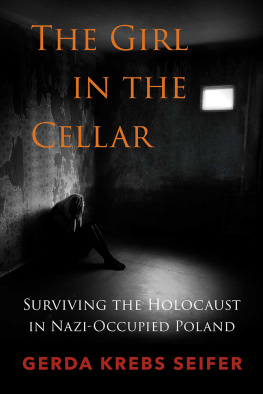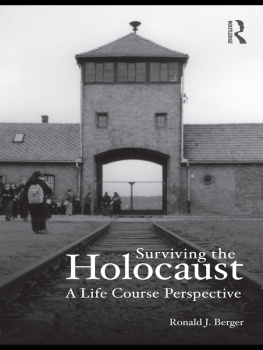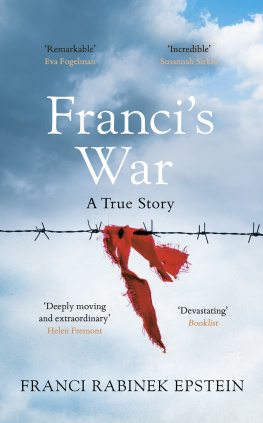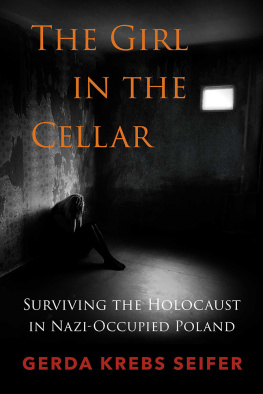Copyright 2019 by Gerda Krebs Seifer
All rights reserved. This book or any portion thereof may not be reproduced or used in any manner whatsoever without the express written permission of the publisher except for the use of brief quotations in a book review.
Print ISBN: 978-1-54396-704-3
eBook ISBN: 978-1-54396-705-0
For my beloved parents,
Edyta Goliger Krebs and Henryk Krebs
Acknowledgements
I would like to thank Professor Bill Younglove for his early help and encouragement in my memoir writing. Over the course of months and years, I sent him emails upon emails of my individual essays. He patiently checked, re-checked, and corrected my mistakes and duplications. I truly appreciate his opinion of my memoir writing, though I feel he has been too generous in his praise.
When Bill taught the history of the Second World War at Millikan High School in Long Beach, he invited me to speak to his class each year. After he retired, our paths crossed again during the planning stages of the Teachers Workshop on the Holocaust at CSULB, along with Professors Jeff Blutinger and Don Schwartz. I learned how intimately he is involved in the study of the Holocaust, the number of meetings he attends, and the many boards he serves on. He knows so much and is so dedicated, and I am sincerely grateful for all he has done for me.
Bill, thank you, thank you, thank you!
To Ellie Brook, who was the first to encourage me to write my story and who is a dear friend. Ellie introduced me to Cecilia Fannon, my editor.
To Cecilia, for helping me see my memoir to completion.
And especially to Harold, for his lifelong and unflagging support.
Foreword
I am so very pleased that Gerda Seifer has, at long last, literally, committed to telling her complete story. As many Southern California community members certainly well know, Gerda is a Holocaust survivor. Parts of her extraordinary life have been shared in various books, newspaper accounts, via electronic media, and in various museums. She has also shared with countless audiences over many decades just how she managed to survive the Nazis attempt to destroy her familys city, home, possessions, livelihoods, and, finally, the members very lives. She describes here, in great detail, for the first time, the incredible, rich tapestry of home life that her loving parents had created for her and how the perpetrators, Hitlers henchmen, destroyed her fathers business, forced the family into the ghetto, and, ultimately, transported Gerdas loved ones to their deaths. Only Gerdas acquired survival skills, wisdom of her parents, luck via somewhat righteous Gentiles, and incredible perseverance, gave her the opportunity at life beyond the Third Reichs annihilation plan for all Jews.
As Gerda succinctly puts it: One moment she was a Polish girl, one with everything to live for, surrounded by comfort; buttressed by friends, playmates, and classmates, and loved by two adoring parents. In the moments after the September 1, 1939 invasion of Poland, however, Gerda learned, painfully so, that she was, in German parlance, an Untermensch a subhuman without human rights. What should have been her time of physically and mentally growing into adulthood, suddenly became, instead, five long years of fear, doubt, subterfuge, hiding in a cellar, household slavery, and the destruction of both her beloved parents.
Numerous times I have heard Gerda paint a verbal portrait of her mother, particularly. The montage that emerges of smells, foods, songs, dresses, movies, and faces culminate in remembrances, always, of Mamusia. Whether it was obtaining a new doll, a trip taken to outfit her preteen bedroom, a visit to an art show, attending an opera, daily studies at the dining tableor even a reprimand for too childish actions, Gerda shares the love, devotion, and wisdom with which her truly remarkable mother endowed her.
In many respects, Gerdas story is best described by the words beyond survival. Sparedbarelyby the degradation of the camps, but not the ghetto, she lived for some five years on the verge of a captivity that few youths in their teen years will ever have to experience. The unknowns about her parents own deaths haunted her for years. This book you have picked up to read is the complete tale of Gerdas own odyssey. It has been a lifelong journey, to recover self, seek out those traumatic truths of her interrupted girlhoodand, interwovenbuild a life anew in a place, a time, and a country that has, for the most part, valued the talents that those of the Jewish faith and culture have to bring, which are immeasurable. Thanks to people like Gerda, her beliefsand her tenacitywill assure her own familial descendants, one moment, a girl or boy; the next, deservedly so, a world of opportunity.
The University of Southern California Visual Shoah Foundation is creating a hologram of Holocaust survivor testimony. Eventually, we are told, future students will be able to enter a circular auditorium and meet, and even question, a three-dimensional, projected image of a, perhaps, long-deceased Holocaust, or genocide, survivor telling his or her story.
I remember, however, an afternoon when Gerda, perhaps halfway through her years of such presentations, spoke to my sixth period class at a local high school. One young girl, very much in the dress style of then-popular punk rock, complete with miniskirt, sleeveless blouse, flaming redand bluehair, pierced nose, eyebrows, lips, and tongue, sat in a front row seat, not over six feet from Gerdas chair. What made this teen most distinctive, however, from the rest of her schools small clique, was what was beneath her torn, fishnet leotard stockings that emanated below that miniskirtall the way to her sandals. Intricately displayed, at two-inch intervals, were carved-in-the-flesh, blue swastikasat least a dozen visible ones on each leg. Complementing them were an equal number of red swastikas from her wrists to the upper edges of her blouse. During Gerdas talk, the girl stared at her, stonily. Within seconds, however, of Gerdas completed tale, the girl stood up, snatched an awaiting floral tribute from a surprised fellow students hands, and proceeded to fling her arms around Gerdas neck. Puzzledand more than a little concernedI worked my way around to Gerdas back to the chalkboard, to see the girls face. It was covered with tears. The wetness was already causing her heavy black mascara to run in streams down her face, over the flowers, and, indeed, onto Gerdas own dress. After seemingly interminable moments, the girl abruptly broke her hold and ran out the door and down the hallway.
My concern now? It is mainly this: How will children of the future be able to embrace a hologram? Doing so is elusive. Gerdas presencesand willingness to share, howeverhave helped create future allies in fighting recurring human atrocities. So, just as the rest of my students have enthusiastically applauded Gerdas sharings over the years, I applaud those readers who have chosen to learn more about her remarkable life, recovered from an evil that, in different disguises, still inhabits, our fragile world.
Bill Younglove
Professor Emeritus
California State University Long Beach
Authors Note
Some years ago, after telling my story of surviving the Holocaust to Professor Jeff Blutingers class at Cal State University Long Beach, I had an idea about creating a workshop for junior and senior high school educators to learn in detail about the Nazi genocide so that they, in turn, could teach the subject to their students. Jeff and Professors Don Schwartz and Bill Younglove were enthusiastic about my idea. With their help and seed money from donors such as myself, my husband, Dr. Harold Seifer, Eugene and Eva Schlesinger, and many other generous members of the Long Beach Jewish community, the Trained Endowed Teacher Workshop on the Holocaust began in August 2009. It has been enormously successful with the participants, and I have had the privilege of telling my story every summer since then.









